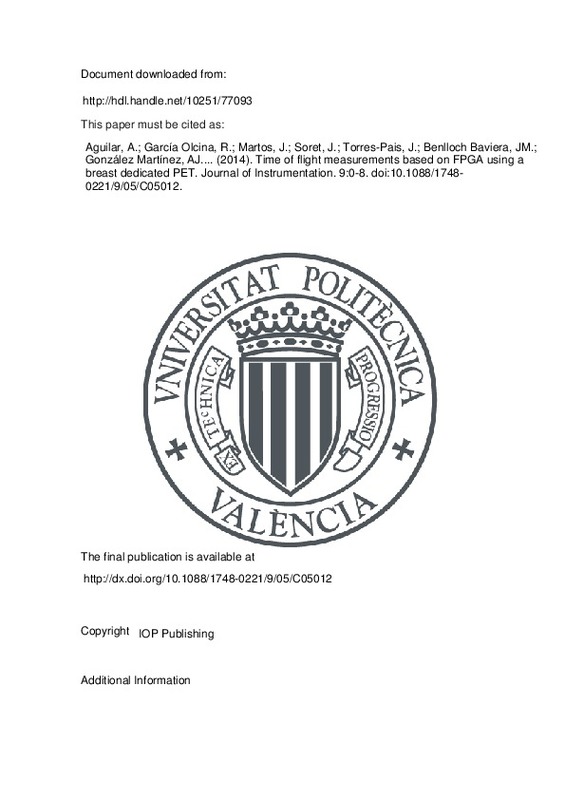JavaScript is disabled for your browser. Some features of this site may not work without it.
Buscar en RiuNet
Listar
Mi cuenta
Estadísticas
Ayuda RiuNet
Admin. UPV
Time of flight measurements based on FPGA using a breast dedicated PET
Mostrar el registro sencillo del ítem
Ficheros en el ítem
| dc.contributor.author | Aguilar, A.
|
es_ES |
| dc.contributor.author | García Olcina, Raimundo
|
es_ES |
| dc.contributor.author | Martos, J.
|
es_ES |
| dc.contributor.author | Soret, J.
|
es_ES |
| dc.contributor.author | Torres-Pais, Jose
|
es_ES |
| dc.contributor.author | Benlloch Baviera, Jose María
|
es_ES |
| dc.contributor.author | González Martínez, Antonio Javier
|
es_ES |
| dc.contributor.author | Sánchez Martínez, Filomeno
|
es_ES |
| dc.date.accessioned | 2017-01-20T11:41:28Z | |
| dc.date.available | 2017-01-20T11:41:28Z | |
| dc.date.issued | 2014-05 | |
| dc.identifier.issn | 1748-0221 | |
| dc.identifier.uri | http://hdl.handle.net/10251/77093 | |
| dc.description.abstract | In this work the implementation of a Time-to-Digital Converter (TDC) using a Nutt delay line FPGA-based and applied on a Positron Emission Tomography (PET) device is going to be presented in order to check the system’s suitability for Time of Flight (TOF) measurements. In recent years, FPGAs have shown great advantages for precise time measurements in PET. The architecture employed for these measurements is described in detail. The system developed was tested on a dedicated breast PET prototype, composed of LYSO crystals and Positive Sensitive Photomultipliers (PSPMTs). Two distinct experiments were carried out for this purpose. In the first test, system linearity was evaluated in order to calibrate the time measurements, providing a linearity error of less than 2% and an average time resolution of 1.4 ns FWHM. The second set of measurements tested system resolution, resulting in a FWHM as good as 1.35 ns. The results suggest that the coincidence window for the current PET can be reduced in order to minimize the random events and thus, achieve better image quality | es_ES |
| dc.language | Inglés | es_ES |
| dc.publisher | IOP Publishing | es_ES |
| dc.relation.ispartof | Journal of Instrumentation | es_ES |
| dc.rights | Reserva de todos los derechos | es_ES |
| dc.subject | Instrumentation and methods for time-of-flight (TOF) spectroscopy | es_ES |
| dc.subject | Trigger detectors | es_ES |
| dc.subject.classification | TEORIA DE LA SEÑAL Y COMUNICACIONES | es_ES |
| dc.title | Time of flight measurements based on FPGA using a breast dedicated PET | es_ES |
| dc.type | Artículo | es_ES |
| dc.identifier.doi | 10.1088/1748-0221/9/05/C05012 | |
| dc.rights.accessRights | Abierto | es_ES |
| dc.contributor.affiliation | Universitat Politècnica de València. Instituto Universitario Mixto de Biología Molecular y Celular de Plantas - Institut Universitari Mixt de Biologia Molecular i Cel·lular de Plantes | es_ES |
| dc.contributor.affiliation | Universitat Politècnica de València. Instituto Universitario de Telecomunicación y Aplicaciones Multimedia - Institut Universitari de Telecomunicacions i Aplicacions Multimèdia | es_ES |
| dc.contributor.affiliation | Universitat Politècnica de València. Instituto de Instrumentación para Imagen Molecular - Institut d'Instrumentació per a Imatge Molecular | es_ES |
| dc.description.bibliographicCitation | Aguilar, A.; García Olcina, R.; Martos, J.; Soret, J.; Torres-Pais, J.; Benlloch Baviera, JM.; González Martínez, AJ.... (2014). Time of flight measurements based on FPGA using a breast dedicated PET. Journal of Instrumentation. 9:0-8. doi:10.1088/1748-0221/9/05/C05012 | es_ES |
| dc.description.accrualMethod | S | es_ES |
| dc.relation.publisherversion | http://dx.doi.org/10.1088/1748-0221/9/05/C05012 | es_ES |
| dc.description.upvformatpinicio | 0 | es_ES |
| dc.description.upvformatpfin | 8 | es_ES |
| dc.type.version | info:eu-repo/semantics/publishedVersion | es_ES |
| dc.description.volume | 9 | es_ES |
| dc.relation.senia | 283577 | es_ES |







![[Cerrado]](/themes/UPV/images/candado.png)

